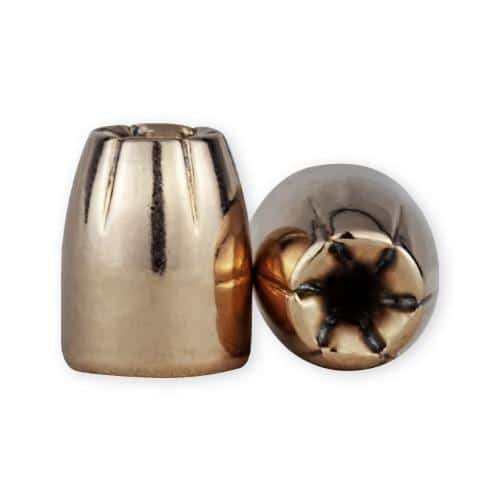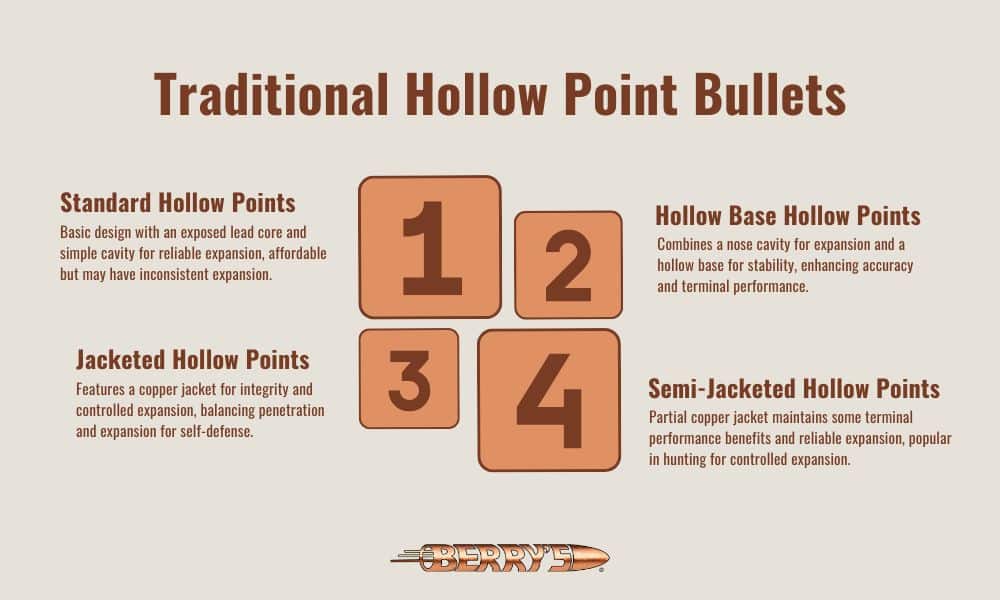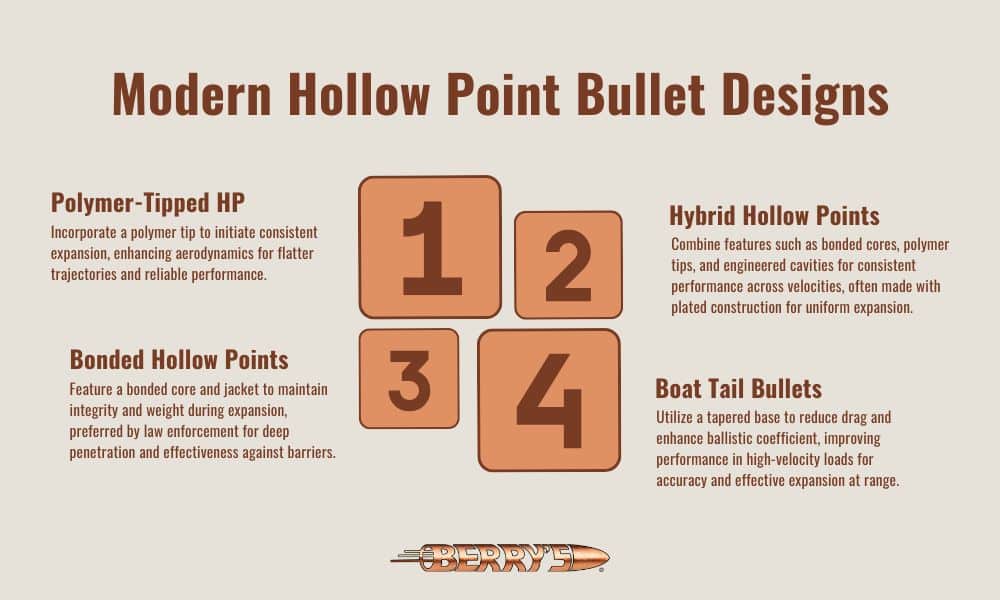Your cart is currently empty!

Types of Hollow Point Bullets
Table of Contents:
- What is a Hollow Point Bullet?
- Traditional Hollow Point Bullet Designs
- Modern Hollow Point Bullet Designs
- Choosing the Right Type of Bullet for Your Needs
- Why Choose Berry’s for Your Hollow Point Bullets
The Short Answer: Hollow point bullets are specialized ammunition designed with a recessed cavity in the tip that causes the bullet to expand upon impact, creating a larger wound channel while reducing the risk of over-penetration. The main types include standard hollow points, jacketed hollow points (JHP), polymer-tipped hollow points, soft point hollow points, hybrid hollow points, copper hollow points, and bonded hollow points.
Hollow point bullets have become a staple in both civilian and law enforcement arsenals due to their effectiveness and safety advantages over typical round nose bullets. Their distinctive design allows them to transfer more energy to the target while minimizing the risk of collateral damage from pass-through.
When choosing a hollow point bullet, understanding the differences between types is crucial. Each hollow point bullet type serves specific purposes – from self-defense to hunting – with varying expansion rates, penetration depths, and terminal performance. The right hollow point depends on your intended use, firearm type, and specific defense or sporting needs.
What is a Hollow Point Bullet?

Basic Design and Function
A hollow point bullet features a distinctive cavity or depression in its tip, designed to initiate controlled expansion upon impact with a target. Unlike full metal jacket (FMJ) bullets which maintain their shape after impact, hollow point bullets expand or “mushroom,” creating a larger wound channel and transferring more energy to the target. This cavity is the key feature that distinguishes hollow point ammunition from other ammo types.
The hollow cavity disrupts the bullet’s structural integrity at the tip, causing it to deform predictably when it encounters resistance from soft tissue. As the bullet expands, its diameter increases significantly—often to 1.5-2 times its original size—which maximizes tissue damage while reducing penetration depth.
Historical Development
Hollow point bullets trace their origins to the late 19th century with the development of the “dum dum” bullet at the British Arsenal in Dum Dum, India. These early designs were crude by today’s standards but established the concept of expanding ammunition. Modern hollow point technology emerged in the mid-20th century and continues to evolve with advancements in metallurgy and design.
Legal Considerations
While the Hague Convention of 1899 prohibited the use of expanding bullets in international warfare, hollow point ammunition remains legal for civilian self-defense, law enforcement, and hunting in the United States. This distinction exists because the military prioritizes incapacitation without excessive tissue damage, while self-defense applications benefit from the reduced risk of over-penetration and rapid energy transfer that hollow points provide.
Performance Benefits
The primary advantages of hollow point bullets include:
- Improved stopping power through rapid energy transfer
- Reduced risk of collateral damage from over-penetration
- Increased terminal effectiveness in soft tissue
- More reliable incapacitation of threats or game animals
These performance characteristics make hollow point ammunition the preferred choice for both personal protection and hunting applications when compared to non-expanding bullet types.
Traditional Hollow Point Bullet Designs

Standard Hollow Points
The most basic form of hollow point bullets features a simple cavity in the nose. These traditional designs rely on a lead core that deforms upon impact, with the hollow cavity initiating expansion. Standard hollow points remain popular for their straightforward effectiveness and relatively low cost.
Without a protective jacket, these bullets can experience inconsistent expansion, especially when passing through barriers like clothing. The exposed lead can also deform during feeding, affecting accuracy and reliability in semi-automatic firearms.
Jacketed Hollow Points (JHP)
The jacketed hollow point represented a significant advancement in bullet technology. By surrounding the lead core with a copper jacket, manufacturers created a bullet that maintained its integrity during feeding while still expanding reliably upon impact. The jacket controls the expansion rate and helps the bullet penetrate barriers before expanding into soft tissue.
JHP bullets typically retain more weight during expansion than standard hollow points, resulting in deeper penetration. This balance of penetration and expansion makes JHP among the most popular bullet types for self-defense applications.
Hollow Base Hollow Points
A specialized design combining two different bullet features, hollow base hollow points feature both a cavity in the nose for expansion and a concave base for improved stability. When fired, propellant gases push against the hollow base, causing it to expand and engage the rifling more effectively, enhancing accuracy.
This dual-feature design offers both improved terminal performance and better flight characteristics. While less common than other designs, these bullets excel in applications where both expansion and exceptional accuracy are required.
Semi-Jacketed Hollow Points
Semi-jacketed hollow points represent a middle ground between standard and fully jacketed designs. The jacket covers only a portion of the bullet, leaving an exposed lead tip with the hollow cavity. This design promotes reliable expansion while maintaining some of the terminal performance advantages of exposed lead.
The limited jacket also reduces feeding issues in semi-automatic firearms while keeping manufacturing costs lower than fully jacketed designs. These bullets are particularly popular for hunting applications where controlled expansion is essential.
Modern Hollow Point Bullet Designs

Polymer-Tipped Hollow Points
A significant innovation in modern hollow point design is the addition of a polymer tip or plastic insert. This design addresses a key weakness of traditional hollow points: inconsistent expansion when passing through barriers. The polymer tip acts as a wedge upon impact, initiating reliable expansion even after passing through clothing.
These bullets offer excellent feeding reliability due to their smooth profile along with consistent expansion performance. The polymer tip also improves aerodynamic efficiency, resulting in flatter trajectories at longer ranges.
Bonded Hollow Points
Bonded hollow points focus on ensuring bullet integrity during expansion. In these designs, the lead core is chemically or metallurgically bonded to the copper jacket, preventing separation upon impact even when striking hard barriers.
This technology allows the bullet to maintain nearly 100% of its weight during expansion, ensuring deeper penetration while still creating substantial wound channels. Law enforcement agencies frequently choose bonded hollow points for their reliable performance against barriers.
Hybrid Hollow Points
The latest evolution in hollow point technology, hybrid designs combine multiple features from various bullet types. These sophisticated bullets might incorporate a bonded core for weight retention, a polymer tip for consistent expansion, and engineered cavities that perform consistently across different velocities.
Many hybrid hollow points feature a plated rather than jacketed construction, where copper is electroplated onto a swaged lead core. This manufacturing process creates a consistent bullet with excellent expansion characteristics.
Boat Tail Bullets
Modern rifle bullets often incorporate a boat tail bullet design—a tapered base that reduces drag and improves ballistic coefficient. This feature is valuable in higher velocity loads where aerodynamic efficiency affects performance at longer ranges. By combining hollow point expansion with improved flight characteristics, these designs excel in both accuracy and stopping power.
Choosing the Right Type of Bullet for Your Needs
Self Defense Applications
For personal protection, bullet selection should prioritize reliable expansion and adequate penetration. The FBI recommends 12-18 inches in ballistic gelatin to reach vital organs while minimizing over-penetration.
The 9mm, .38/.357, .40, and .45 calibers are effective choices with quality hollow point ammunition. Smaller calibers like .380 work for concealed carry when using premium hollow points designed for lower velocities.
Modern jacketed or plated hollow points offer the best balance of expansion, penetration, and reliability. Look for designs that perform consistently even after passing through clothing.
Hunting Applications
For hunting, bullet selection varies by game size and conditions. Hunters should check local regulations, as many areas require a valid hunting license and have specific ammunition restrictions.
Larger hollow cavities are ideal for varmint hunting where rapid expansion is desired. For medium and large game, bonded or hybrid hollow points provide the controlled expansion and penetration needed for ethical harvests.
Training Considerations
While hollow points are optimal for defensive use, many practice with full metal jacket bullets due to cost. However, periodic training with your chosen self-defense ammunition is essential to verify reliability and adjust to its different recoil characteristics.
Why Choose Berry’s for Your Hollow Point Bullets
When your life depends on your bullets, quality matters. Berry’s Bullets has revolutionized the self-defense market with our line of self-defense bullets. What sets Berry’s apart is their proprietary manufacturing process—starting with a carefully engineered swaged lead core that’s precision electroplated with copper to achieve optimal weight distribution and dimensional consistency.
This innovative copper-plated design represents the perfect middle ground between cost-effective cast bullets and performance-oriented jacketed hollow points. Berry’s manufacturing technique delivers exceptional reliability and performance that serious shooters demand at a competitive price point. The HHP line is available across all common defensive calibers: .380, 9mm, .38/.357, .40, and .45.
Check out Berry’s Self-Defense Bullets for bullets that deliver reliable performance, shot after shot.
